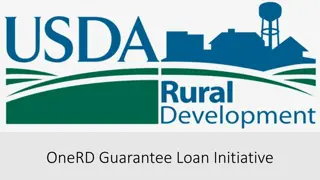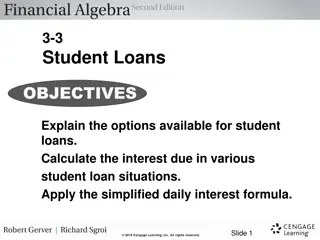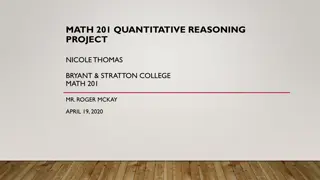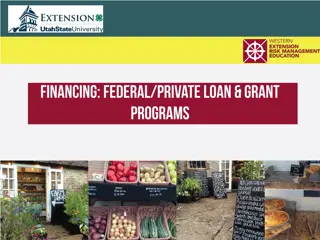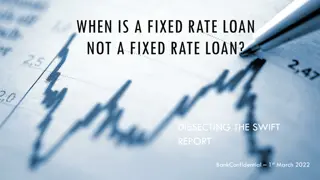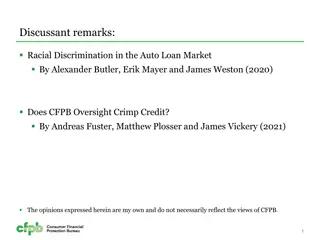Understanding Marketing Assistance Loans (MAL) and Loan Deficiency Payments (LDP) for Farmers
Farmers can benefit from Marketing Assistance Loans (MAL) and Loan Deficiency Payments (LDP) to manage cash flow and ensure price floors for their harvested grain. MAL offers low-interest loans while LDP provides payments if prices fall below a certain level, offering financial support during challenging market conditions.
Download Presentation

Please find below an Image/Link to download the presentation.
The content on the website is provided AS IS for your information and personal use only. It may not be sold, licensed, or shared on other websites without obtaining consent from the author. Download presentation by click this link. If you encounter any issues during the download, it is possible that the publisher has removed the file from their server.
E N D
Presentation Transcript
FARM BILL SUPPORT PROGRAMS: A FARMER PERSPECTIVE PART 2 AAE 320 Paul D. Mitchell Agricultural and Applied Economics
Learning Goals Learning Goal: To understand how specific commodity support programs operate for an individual farmer Part 1 Price Loss Coverage (PLC) Agricultural Risk Coverage (ARC) Part 2 Marketing Assistance Loans (MAL) Dairy Margin Coverage (DMC) Briefly Market Facilitation Program (MFP) Coronavirus Food Assistance Program (CFAP, CFAP2)
Marketing Assistance Loans (MAL) and Loan Deficiency Payments (LDP)
Marketing Assistance Loans (MAL) and Loan Deficiency Payments (LDP) Crop prices tend to be low around harvest time, but that is also when many operating loans are due Marketing Assistance Loans (MAL): low interest loans to help farmers manage cash flow (pay off operating loans), so can wait to sell grain when prices are higher Loan Deficiency Payments (LDP): Payments that give farmers a price floor equal to the Loan Rate used for MAL MAL-LDP programs meant to work together Not tied to Base Ares or Program Yields but actual production
Marketing Assistance Loans Farmers receive a marketing assistance loan (MAL) from the Commodity Credit Corporation (CCC), using their harvested grain as collateral Your harvested grain, no matter how many acres grown on Receive $/bu in loan equal to the Loan Rate National Loan Rates: Corn $2.20, Soybeans $6.20, Wheat $3.38 Each county s loan rates differ from these by a few cents WI tends to be lower: 2020 Dane $2.15, $6.21, $3.36 Must grow the grain yourself, can t buy from someone else and then enroll it in MAL MAL is for up to 9 months
MAL Payback Farmer picks a day to sell grain used as collateral and payoff loan Actual physical sale may occur later, but not earlier Each day, there is a Posted County Price (PCP) for each commodity, official FSA estimate of local price If PCP > Loan Rate, farmer pays back MAL in full, plus small interest payment If PCP < Loan Rate, farmer pays back MAL at Marketing Loan Repayment Rate PCP Loan Deficiency Payment (LDP) = Loan Rate PCP Simplification: Don t take loan and pay it back, but receive LDP = Loan Rate PCP, if PCP < Loan Rate Program used to be used a lot when lower prices
Think Break #13 1. Suppose you harvested 5,000 bu of soybeans and enrolled all 5,000 bu for a Marketing Assistance Loan If soybeans has a $6.20/bu loan rate, so how much will your MAL be? 2. Suppose you pay back the MAL on Feb 1stwhen the posted county price for soybeans is $7.00/bu What is your Loan Deficiency Payment? How much will you pay back? 3. Suppose instead you pay back the MAL on Feb 15thwhen the posted county price for soybeans is $6.00/bu What is your Loan Deficiency Payment? How much will you pay back?
Think Break #13: Answer 1. How much will your MAL be? MAL = $6.20/bu x 5,000 bu = $31,000 2. Suppose you pay back the MAL on Feb 1stwhen the posted county price for soybeans is $7.00/bu a. What is your Loan Deficiency Payment? $0 b. How much will you pay back? $31,000 3. Suppose instead you pay back the MAL on Feb 15thwhen the posted county price for soybeans is $6.00/bu a. What is your Loan Deficiency Payment? $6.20 $6.00 = $0.20/bu x 5,000 bu = $1,000 b. How much will you pay back? Original loan LDP = $31,000 $1,000 = $30,000
Summary of Loan Deficiency Payments (LDP) LDP ($/harvested bushel) LDP = Loan Rate PCP, if PCP < Loan Rate Depends on local Posted County Price when you sell the crop (may not be price actually received when physical sale occurs) Can use the grain to feed your livestock after pay back loan Depends on how many bushels harvested, not acres harvested Gives farmers Loan Rate as minimum price on all bushels enrolled ~ Corn $2.20, Soybeans $6.20, Wheat $3.38
Marketing Assistance Loans (MAL) and Loan Deficiency Payments (LDP) Combined programs give farmers a price floor equal to the Loan Rate Reality is that loan rates are so low for corn soybeans and wheat that generally no one expects LDPs, just use MALs as a cheap loan program LDPs have been paid in recent years for some classes of wheat and Southern crops (peanuts, cotton, rice) Based on actual farmer harvested production and local prices (but not actual price you sell for) MAL/LDPs do not use National MYA prices, Base Acres or Program Yields, but the loan rate, posted county price and actual production
MAL Used for ~1 Billion bu in 2017 (~ 7% of production) but actual government cost is far below ARC+PLC cost CBO Projected Spending on MAL 80 70 60 Government Spending ($M) 50 40 30 20 10 0 2018 2020 2022 2024 2026 2028
Dairy Margin Coverage (DMC) 2018 Farm Bill: new dairy program: Dairy Margin Coverage (DMC) Replaced unpopular Dairy Margin Protection Program (MPP) from the 2014 Farm Bill, which replaced Milk Income Loss Coverage (MILC) DMC like MPP, but with tweaked parameters and a new name Makes payments in a month when the difference between the USDA s average national All-Milk price and a program-defined fixed feed ration valued at U.S. average prices falls below the margin (Income Over Feed Costs) Margin used to pay fixed costs, overhead, management National all milk price is $16/cwt and the USDA ration cost is $10/cwt, then the IOFC margin that month is $16.00 $10.00 = $6.00
Dairy Margin Coverage (DMC) Farmer chooses 1) Margin Guarantee (All Milk Price Feed Cost) $4.00/cwt to $9.50/cwt in 50 increments 2) % of Production to Cover (Payment Rate) % of monthly production paid for if the Actual Margin < Guarantee 25% to 95% in 5% increments Margins are checked each month and payments made accordingly Voluntary program with annual coverage decisions Enroll until 2023 for 25% premium discount Farmer gets $4/cwt margin for free, pay for higher margin, with higher premium for production over 5 million pounds
DMC Example Payment Calculation Suppose your farm produces 3 million pounds of milk per year (30,000 cwt) About 111 cows at 27,000 lbs/yr per cow For 2020, you bought the maximum $9.50 margin guarantee and the maximum coverage of 95% of your production at $0.15/cwt Annual Cost = 30,000 cwt x 95% x $0.15/cwt = $4,275 Suppose in March 2020 the actual announced dairy margin (income over feed costs) is $9.05, which triggers a DMC payment Your payment would be $9.50 $9.05 = $0.45/cwt Your average monthly production is 30,000 cwt / 12 = 2,500 cwt, but your covered production is 95% x 2,500 cwt = 2,375 cwt You would be paid $0.45/cwt x 2,375 cwt = $1,068.75 for March 2020
Get updated margin projections https://dairymarkets.org/Tools/MILC-MPP.html
Get updated margin projections https://dairymarkets.org/Tools/MILC-MPP.html
DMC Premium Costs ($/cwt) 5 million pounds at 27,000 pounds per cow per year = 185 cows $9.50 margin, 5 million pounds, cover 95% of production and $0.15/cwt = $7,125 per year Cost to cover production above 5 million pounds rises quickly after the $5.50 margin
Dairy Margin Coverage (DMC) Enrollment Enrollment for each calendar year, opens in October, closes in December 2022: adjusting premiums and the formula for feed rations % Dairies Enrolled Payments ($ Million) US WI 80.9% 84.5% 49.9% 50.3% 75.4% 78.9% Year 2019 2020 2021 US $301 $210 $1,080 WI $66.5 $50.4 $242.7 Source: https://www.fsa.usda.gov/programs-and-services/dairy-margin-coverage-program/program-enrollment-information/index
Dairy Margin Coverage (DMC) Resources USDA FSA page: https://www.fsa.usda.gov/programs-and- services/dairy-margin-coverage-program/index Program on Dairy Markets and Policy has tons of dairy information, including DMC and DMC decision tools https://dairymarkets.org/ Currently down as work to roll out 2022 enrollment
Market Facilitation Program (MFP) In 2018, trade wars led to tariffs on US ag exports and large price declines for several ag commodities Already low prices and low farm income before trade war Administration created the Market Facilitation Program Outside of Farm Bill and usual legislative process, but authorized by CCC Rules were developed and payments announced for 2018 MFP payments announced in 2019, developed different rules MFP is broader than just payments to farmers: Food Purchase & Distribution Program: buy surplus of affected commodities Trade Promotion Program: restore lost markets, develop new export markets
DP ARC PLC Dairy Conservation Ad Hoc Disaster MFP All Other 35 Government Payments by Program 30 CFAP Disaster Payments ($ Billion) 25 20 MFP 15 10 ARC 5 0 2012 2013 2014 2015 2016 2017 2018 2019 2020 2021
MFP 2018 Covered Commodities MFP provides payments to eligible producers of: Non-Specialty Crops: alfalfa hay, barley, canola, corn, crambe, dried beans, dry peas, extra-long staple cotton, flaxseed, lentils, long grain and medium grain rice, millet, mustard seed, oats, peanuts, rapeseed, rye, safflower, sesame seed, small and large chickpeas, sorghum, soybeans, sunflower seed, temperate japonica rice, triticale, upland cotton, and wheat Specialty Crops: almonds, cranberries, cultivated ginseng, fresh grapes, fresh sweet cherries, hazelnuts, macadamia nuts, pecans, pistachios, and walnuts Livestock: dairy and hogs
MFP Eligibility Produce one or more of these commodities, and must either: 1) Have an average AGI for tax years 2015-2017 < $900,000 OR 2) Derive at least 75% of AGI from farming or ranching Producers also must: Comply with the provisions of the Highly Erodible Land and Wetland Conservation regulations, often called Conservation Compliance provisions Have a farm serial number with USDA's Farm Service Agency Notice: did not need base acres
MFP Payments 2018: MFP payments based on farmer s production of affected commodities: Soybeans = $1.62/bu, Wheat = $0.14/bu, Corn = $0.01/bu Dairy = $0.12/cwt 2019: MFP payments based on total acres of affected commodities a farmer planted, each county had a different rate Acres instead of production (was it decoupled?) Specialty crops were also paid on per acre basis Cranberry and Ginseng the major WI crops
MFP Payments for 2018 2018 MFP payments exceeded $200 Million in WI: Soybeans $166 Million, Dairy $28 Million, Corn $5 Million https://www.fb.org/market-intel/mapping-8.5-billion-in-trade-assistance
MFP Payment Rates for 2019 https://www.agri-pulse.com/articles/12457-map-a-look-at-where-the-mfp-payments-are-going
2019 MFP Payment Rates in WI https://renk.aae.wisc.edu/2019/08/05/market-facilitation-program-what-it-means-for-wisconsin-producers/
Market Facilitation Program (MFP) MFP a temporary (ad hoc) program outside of the Farm Bill to give farmers a major influx of money when needed FSA quickly created program in 2018, then changed rules for 2019 Key point: It was temporary: the budgetary authority ($30 Billion) is almost fully spent and trade war (hopefully) ending With pandemic, Congress increased the budgetary authority again for CFAP, CFAP2 Several WI crops are still suffering from trade war tariffs
Coronavirus Food Assistance Program (CFAP) part of the CARES Act that passed March 27, 2020
Coronavirus Food Assistance Program (CFAP) USDA partnered with local distributors to buy and distribute food boxes (like a federally sponsored food bank) Direct support to farmers: crop and livestock For farmers, CFAP sign up ran May 26, 2020 to Sept 11, 2020 Farmers certified their 2019 production inventory as of Jan 15, received payments for crops that suffered > 5% price decline Crops: Corn $0.335/bu, Soybeans $0.475/bu, Oats $0.16/bu, many more Convert silage inventory to grain equivalents Dairy $4.71/cwt for milk production Q1 2020, $1.47/cwt for Q2 2020 Cattle: payments varied with live weight, but as high as $250/head
CFAP2: An Additional $14 Billion CFAP2 passed Sep 17, 2020 Enrollment Sep 21 to Dec 11, 2020 Eligible crops/livestock: If you grow it, likely can get a payment for it! Row crops 2020 production x payment rate Corn $0.232/bu, Soybean $0.3132/bu, Wheat $0.3942/bu Flat rate row crops or acreage-based crops paid $15/ac: Alfalfa Dairy: $2.16/cwt Apr 1 to Dec 31 milk production (dairy goats too!) Beef: Max inventory Apr 16 to Aug 31, 2020 @ $55/head Most other livestock per head as well Specialty Crops: payments based on 2019 sales: 10.6% to 8.8%
DP ARC PLC Dairy Conservation Ad Hoc Disaster MFP All Other 35 Government Payments by Program 30 CFAP Disaster Payments ($ Billion) 25 20 MFP 15 10 ARC 5 0 2012 2013 2014 2015 2016 2017 2018 2019 2020 2021
50 Government Payments to Farmers $45.7 B in 2020 45 Government Payments ($ Billion) 40 35 30 $28.0 B in 2021 25 20 15 10 5 0 1930 1940 1950 1960 1970 1980 1990 2000 2010 2020
% NFI from Government Payments 70% 65% in 1983 60% 48% in 2020 % NFI from Govt Payments 2002-2021 20-year average = 20.4% 50% 40% 30% 25% in 2021 20% 10% 0% 1930 1940 1950 1960 1970 1980 1990 2000 2010 2020
Summary MAL are a part of the Farm Bill going way back: low interest loans to help farms cash flow operating loans & market more effectively MFP and CFAP (1 & 2): Example of rapid response by USDA to create a new program quickly Farmer perspective: another acronym and new set of rules to learn, all part of the job: take advantage of programs as they come Why government payments average about 20% of farm income








